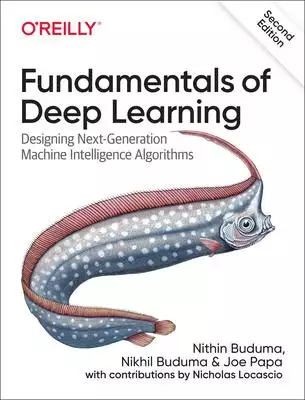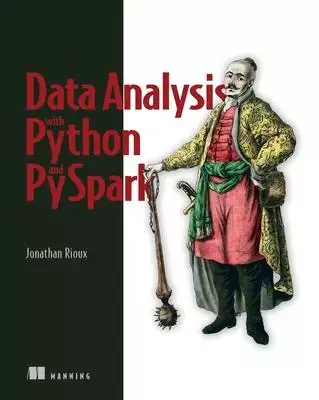Python machine learn的問題,透過圖書和論文來找解法和答案更準確安心。 我們找到下列包括價格和評價等資訊懶人包
Python machine learn的問題,我們搜遍了碩博士論文和台灣出版的書籍,推薦Buduma, Nithin,Buduma, Nikhil寫的 Fundamentals of Deep Learning: Designing Next-Generation Machine Intelligence Algorithms 和Rioux, Jonathan的 Data Analysis with Python and Pyspark都 可以從中找到所需的評價。
這兩本書分別來自 和所出版 。
逢甲大學 通訊工程學系 林維崙所指導 楊旻戰的 帶有記憶層級的長短記憶神經網路 (2021),提出Python machine learn關鍵因素是什麼,來自於神經網路、長短期記憶模型。
而第二篇論文國立臺北科技大學 工業工程與管理系 邱垂昱所指導 陳建安的 基於機器學習的模型做喜好推薦應用於W公司媒合平台研究 (2021),提出因為有 模型分析、機器學習、分類、極限梯度提升、輕量化梯度提升機的重點而找出了 Python machine learn的解答。
Fundamentals of Deep Learning: Designing Next-Generation Machine Intelligence Algorithms

為了解決Python machine learn 的問題,作者Buduma, Nithin,Buduma, Nikhil 這樣論述:
We’re in the midst of an AI research explosion. Deep learning has unlocked superhuman perception to power our push toward creating self-driving vehicles, defeating human experts at a variety of difficult games including Go, and even generating essays with shockingly coherent prose. But decipherin
g these breakthroughs often takes a PhD in machine learning and mathematics. The updated second edition of this book describes the intuition behind these innovations without jargon or complexity. Python-proficient programmers, software engineering professionals, and computer science majors will be
able to re-implement these breakthroughs on their own and reason about them with a level of sophistication that rivals some of the best developers in the field. Learn the mathematics behind machine learning jargon Examine the foundations of machine learning and neural networks Manage problems that a
rise as you begin to make networks deeper Build neural networks that analyze complex images Perform effective dimensionality reduction using autoencoders Dive deep into sequence analysis to examine language Explore methods in interpreting complex machine learning models Gain theoretical and practica
l knowledge on generative modeling Understand the fundamentals of reinforcement learning
Python machine learn進入發燒排行的影片
ดาวน์โหลด Jupyter Notebook ที่ใช้ในคลิปได้ที่ ► https://github.com/prasertcbs/scikitlearn_tutorial/blob/main/notebook/lightgbm_classifier_titanic.ipynb
เชิญสมัครเป็นสมาชิกของช่องนี้ได้ที่ ► https://www.youtube.com/subscription_center?add_user=prasertcbs
สอน Machine learning ► https://www.youtube.com/playlist?list=PLoTScYm9O0GH_3VrwwnQafwWQ6ibKnEtU
สอน Jupyter Notebook ► https://www.youtube.com/playlist?list=PLoTScYm9O0GErrygsfQtDtBT4CloRkiDx
สอน Python สำหรับ data science ► https://www.youtube.com/playlist?list=PLoTScYm9O0GFVfRk_MmZt0vQXNIi36LUz
สอน pandas ► https://www.youtube.com/playlist?list=PLoTScYm9O0GGsOHPCeufxCLt-uGU5Rsuj
สอน numpy ► https://www.youtube.com/playlist?list=PLoTScYm9O0GFNEpzsCBEnkUwgAwOu_PWw
สอน matplotlib ► https://www.youtube.com/playlist?list=PLoTScYm9O0GGRvUsTmO8MQUkIuM1thTCf
สอน seaborn ► https://www.youtube.com/playlist?list=PLoTScYm9O0GGC9QvLlrQGvMYatTjnOUwR
สอนภาษาไพธอน Python เบื้องต้น ► https://www.youtube.com/playlist?list=PLoTScYm9O0GH4YQs9t4tf2RIYolHt_YwW
สอนภาษาไพธอน Python OOP ► https://www.youtube.com/playlist?list=PLoTScYm9O0GEIZzlTKPUiOqkewkWmwadW
สอนการใช้งานโปรแกรม R: https://www.youtube.com/playlist?list=PLoTScYm9O0GGSiUGzdWbjxIkZqEO-O6qZ
สอนภาษา R เบื้องต้น ► https://www.youtube.com/playlist?list=PLoTScYm9O0GF6qjrRuZFSHdnBXD2KVIC
#prasertcbs_datascience #prasertcbs #prasertcbs_pandas #prasertcbs_sklearn
帶有記憶層級的長短記憶神經網路
為了解決Python machine learn 的問題,作者楊旻戰 這樣論述:
循環神經網路(Recurrent neural network)是人工智慧神經網路領域中處理時序相關的資料常見的一種模型,但此模型有著權重(Weights)梯度爆炸或梯度消失問題,為此加入「閥」(Gate)這個機制去決定資料的保留與刪除的長短期記憶模型(Long short-term memory)可以有效的去解決這個問題。長短期記憶模型(Long short-term memory)利用閥的機制,有效的抑制權重指數爆炸或梯度消失問題,在LSTM模型內部的組件我們可以大致觀察到它將資訊分成長期記憶(C)及短期記憶(H),在此架構下,容易造成因為資料集的特性而使LSTM模型之效能有所差異,為此
我們加入 Layered Memory(M),期望使輸入資料能有更細微的保留與傳遞。本論文使用Python與Tensorflow,建構基於長短期記憶模型(Long short-term memory)加入層式記憶之模擬模型,再以此探討此機制對於模型之效益,在延伸討論此機制在模型內部之連接方式能有效應用細分過後的資料並加以利用,同時與現行的長短期記憶模型進行結果比較。
Data Analysis with Python and Pyspark

為了解決Python machine learn 的問題,作者Rioux, Jonathan 這樣論述:
Think big about your data! PySpark brings the powerful Spark big data processing engine to the Python ecosystem, letting you seamlessly scale up your data tasks and create lightning-fast pipelines.In Data Analysis with Python and PySpark you will learn how to: Manage your data as it scales acros
s multiple machines Scale up your data programs with full confidence Read and write data to and from a variety of sources and formats Deal with messy data with PySpark’s data manipulation functionality Discover new data sets and perform exploratory data analysis Build automated data pipelines that t
ransform, summarize, and get insights from data Troubleshoot common PySpark errors Creating reliable long-running jobs Data Analysis with Python and PySpark is your guide to delivering successful Python-driven data projects. Packed with relevant examples and essential techniques, this practical book
teaches you to build pipelines for reporting, machine learning, and other data-centric tasks. Quick exercises in every chapter help you practice what you’ve learned, and rapidly start implementing PySpark into your data systems. No previous knowledge of Spark is required. Purchase of the print boo
k includes a free eBook in PDF, Kindle, and ePub formats from Manning Publications. About the technology The Spark data processing engine is an amazing analytics factory: raw data comes in, insight comes out. PySpark wraps Spark’s core engine with a Python-based API. It helps simplify Spark’s steep
learning curve and makes this powerful tool available to anyone working in the Python data ecosystem. About the bookData Analysis with Python and PySpark helps you solve the daily challenges of data science with PySpark. You’ll learn how to scale your processing capabilities across multiple machin
es while ingesting data from any source--whether that’s Hadoop clusters, cloud data storage, or local data files. Once you’ve covered the fundamentals, you’ll explore the full versatility of PySpark by building machine learning pipelines, and blending Python, pandas, and PySpark code. What’s inside
Organizing your PySpark code Managing your data, no matter the size Scale up your data programs with full confidence Troubleshooting common data pipeline problems Creating reliable long-running jobs About the reader Written for data scientists and data engineers comfortable with Python. About th
e author As a ML director for a data-driven software company, Jonathan Rioux uses PySpark daily. He teaches the software to data scientists, engineers, and data-savvy business analysts. Table of Contents 1 Introduction PART 1 GET ACQUAINTED: FIRST STEPS IN PYSPARK 2 Your first data program in PySp
ark 3 Submitting and scaling your first PySpark program 4 Analyzing tabular data with pyspark.sql 5 Data frame gymnastics: Joining and grouping PART 2 GET PROFICIENT: TRANSLATE YOUR IDEAS INTO CODE 6 Multidimensional data frames: Using PySpark with JSON data 7 Bilingual PySpark: Blending Python and
SQL code 8 Extending PySpark with Python: RDD and UDFs 9 Big data is just a lot of small data: Using pandas UDFs 10 Your data under a different lens: Window functions 11 Faster PySpark: Understanding Spark’s query planning PART 3 GET CONFIDENT: USING MACHINE LEARNING WITH PYSPARK 12 Setting the stag
e: Preparing features for machine learning 13 Robust machine learning with ML Pipelines 14 Building custom ML transformers and estimators
基於機器學習的模型做喜好推薦應用於W公司媒合平台研究
為了解決Python machine learn 的問題,作者陳建安 這樣論述:
現在是資訊爆炸的時代,在行動裝置與網頁端推出服務越來越多樣化,當我們瀏覽網頁時,輸入資訊搜尋相關資料,同時也會想知道有沒有相關的或是針對我們輸入的關鍵字做出的推薦,如果能利用使用者在網頁或是手機端中留下的資料,追蹤進行蒐集與處理,並以此基礎下做出進一步的喜好推薦。藉由科技發展與創新,有著越來越多的公司與政府單位開始重視數據的運用,政府企業對於數據的來源、收集與整理、以及對演算法模型的預測能力也越來越重視,正因為如此慢慢開始使用自動化機器取代傳統人工的操作去推薦,也期望達到精準的個人化喜好推薦,而加入機器學習的推薦系統,不論是公司或是使用者其實都得到很多好處。有許多人投入推薦的改善與研究,進一
步得到更準確且有效的預測,例如Google、Amazon、阿里巴巴等公司開發的推薦系統搭配雲端運算也能為他們帶來了非常巨大的收益。本研究針對W公司媒合網站後台資料進行資料蒐集、資料處理以及後續分析,運用監督式機器學習商家與網紅的資訊及喜好評分數據來訓練學習,並預測喜好與否,本研究運用多個分類模型做比較,像是支援向量機、隨機森林、邏輯迴歸、極限梯度提升模型與輕量化梯度提升模型,目的在比較和找到最合適的分類器,應用於W公司網站平台,並以此進行分類方法的相關探討與研究,研究結果顯示在我們第三章提到的輕量化梯度提升機準確率有 85.98% 相對第二章提到的其他模型來的更高,也做了交叉驗證平均準確率有
78.57% ,代表該模型具有穩定度對於我們的喜好推薦有良好預測效果。